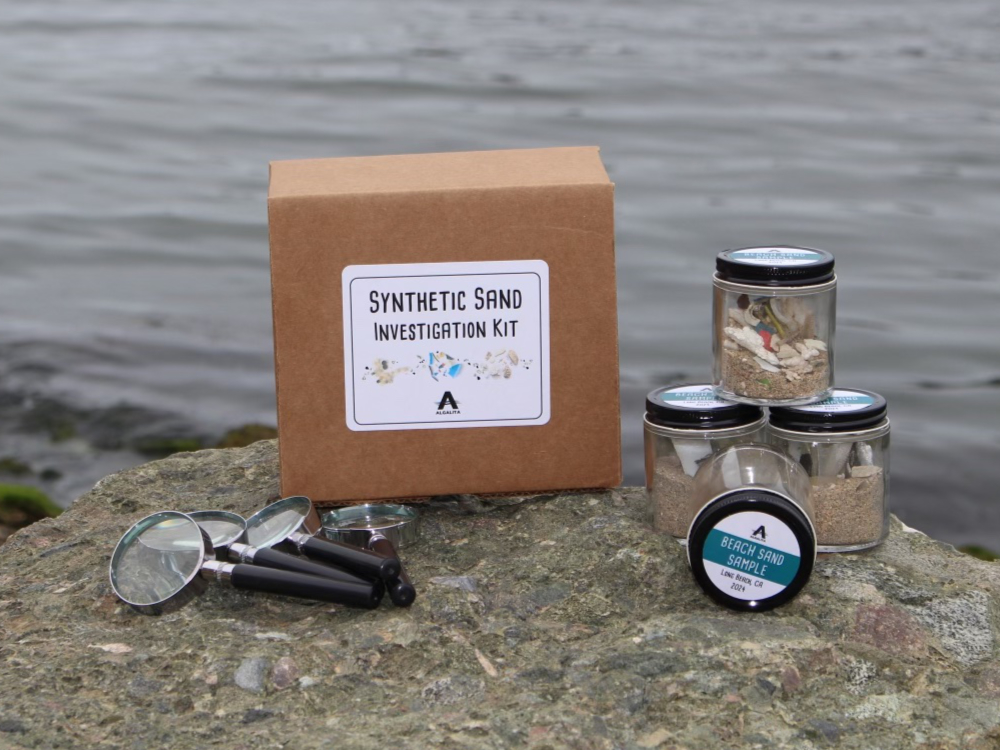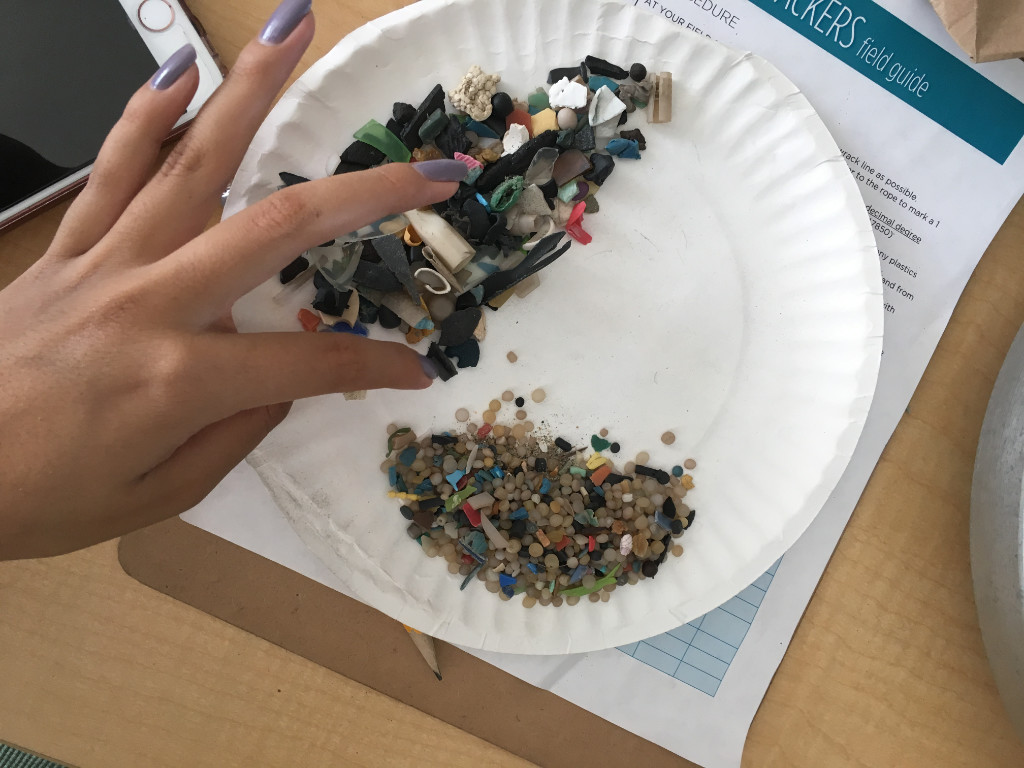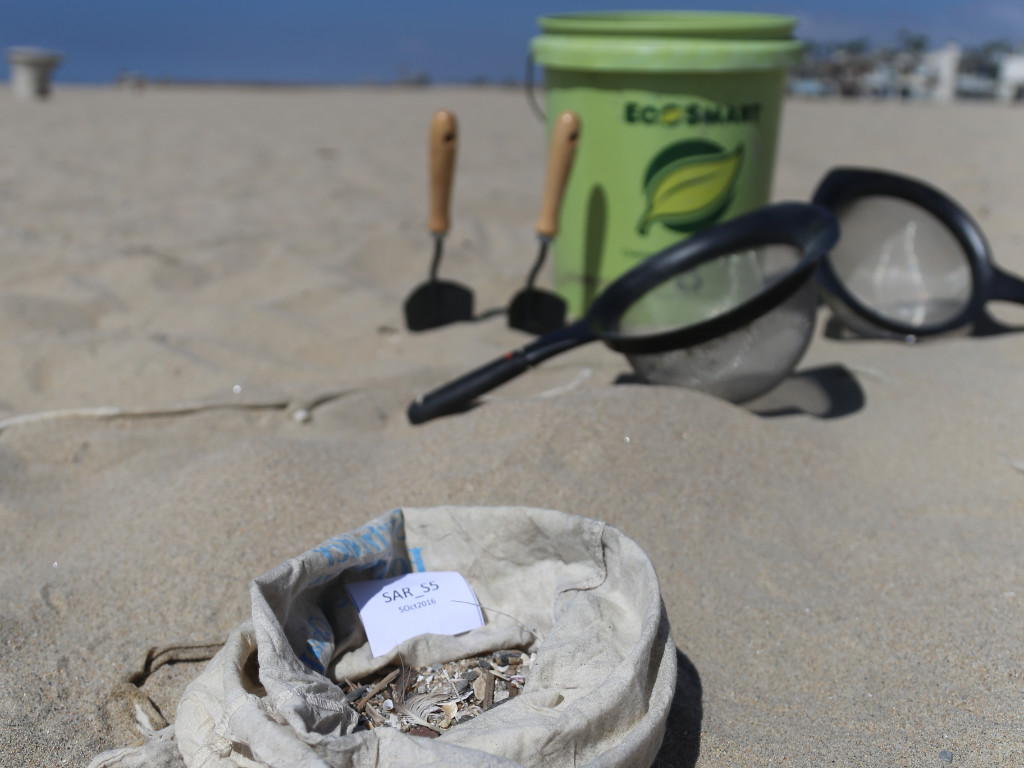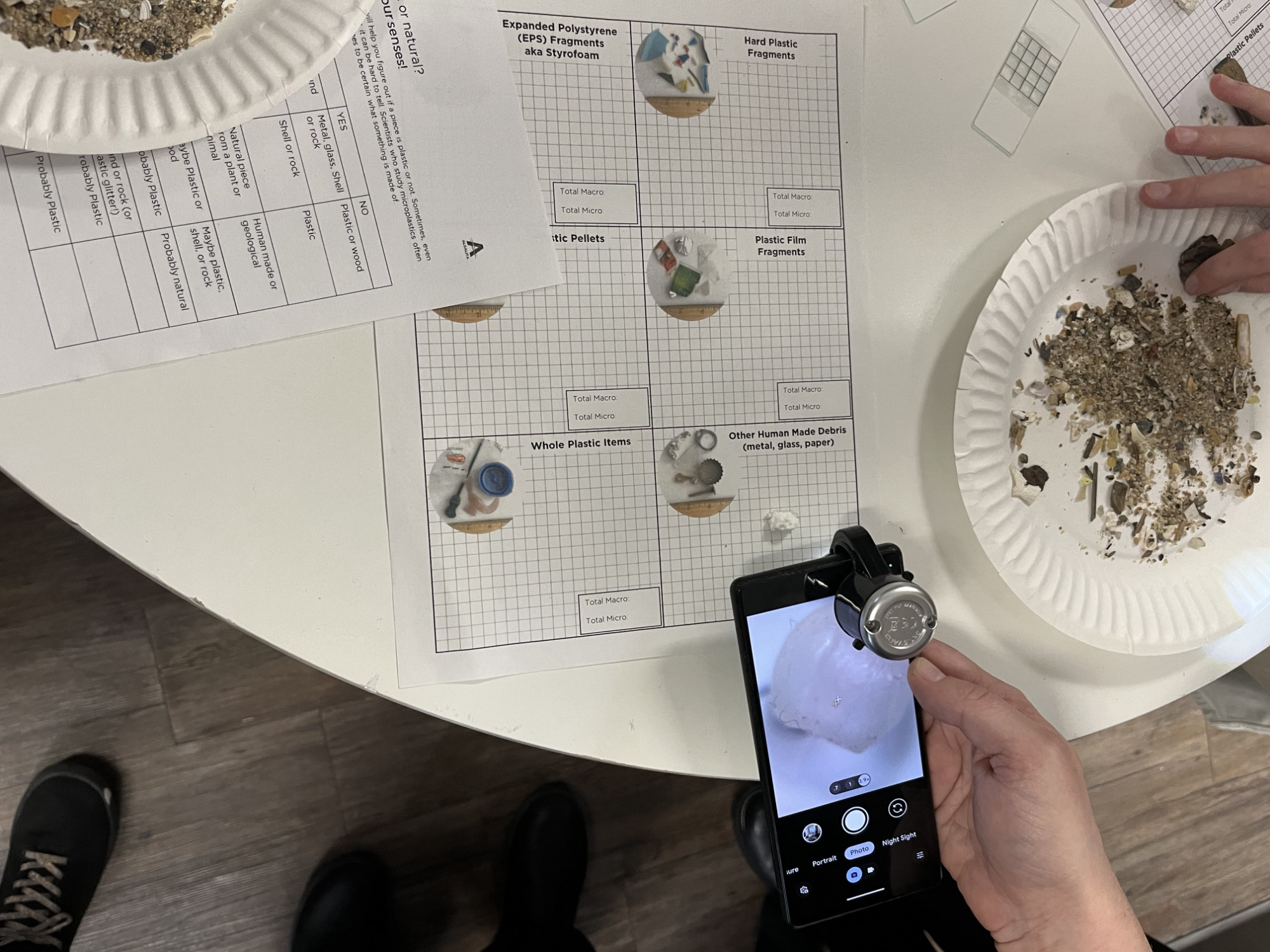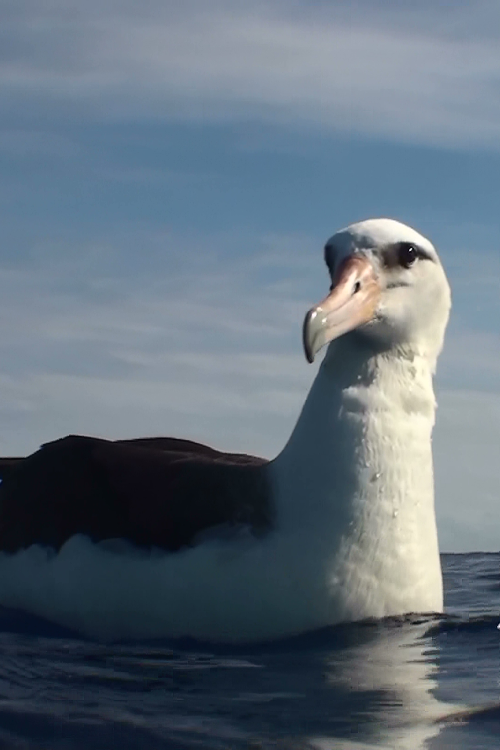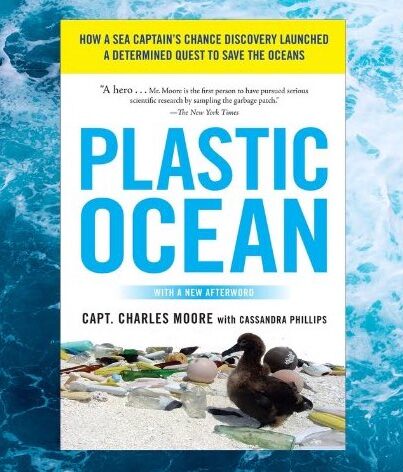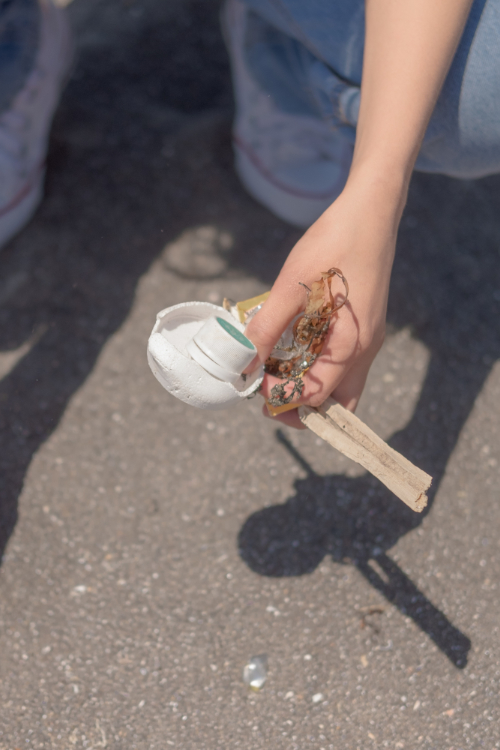
Toolkit
Photo credit: Algalita
Investigate beach sand to identify synthetic and natural materials. Measure plastic pollution levels and describe human impacts on coastal ecosystem health.
Grades 5 and up
Time Needed 30 to 60 minutes, or 2 hour fieldtrip
Related Standards and Units Middle School, Synthetic Materials (MS-PS 1-3), Human Impact on the Environment
* See our Standards Alignment Guide for MS-PS 1-3 Synthetic Materials for our other lessons, videos and actions connected to this standard.
Toolkit Details
What is in the Synthetic Sand Sample Kit?
– 4 sand samples collected from Long Beach and Seal Beach, CA
– 4 magnifying glasses (optional)
– Sample info cards
Materials you’ll need to procure
– 1 paper plate per group of 2 to 4 students
Editable Handouts
– Synthetic Sand – Background and Instructions – PDF
– Synthetic Sand – Microplastic Sorting Sheet – PDF
– Synthetic Sand – Sensory Identification Clue Handout – PDF
– Synthetic Sand – Data Sheet – Google Sheet
– Synthetic Sand – Extension Activity – Google Sheet
Walkthrough Presentation
In this Resource Spotlight, we walk you through the Synthetic Sand investigation activity, discuss how to incorporate it into your Synthetic Materials unit, and provide additional information about plastic pollution and how it is a prime example of how human-made materials impact our planet.
You can use these presentation slides to access links discussed in the video below: Synthetic Sand – Resource Spotlight Presentation – PDF
Alternative Fieldtrip Option / Collect Your Own Samples
Instead of using our Sample Kit, you can collect your own samples or do a class field trip for your students to collect their own samples. You’ll need these items per group: 4 yard rope, 4 pencils (unsharpened ok), 1 shovel, 1 bucket, 1 kitchen strainer, 1 magnifying glass (optional), 1 paper bag, and 1 paper plate. A Synthetic Sand Fieldtrip takes about 2 hours of activity time.
We’ve outlined how to collect your own sample in the following video.
Purpose and Context
Synthetic Materials
Plastics are a type of synthetic material. They are made by chemically altering certain molecules in fossil fuels. Plastics are a big group of materials used to make thousands of different things from packaging, to paint and glue, to our clothing.
What are microplastics?
Often during a beach cleanup, only the big pieces of litter that are easy to see get collected. But, if you take a closer look you might find a much smaller kind of plastic pollution. Scientists who research plastic pollution find lots of tiny plastic particles throughout our environment. These small pieces are called “microplastics” if they are less than 5 millimeters (mm) in size, which is smaller than the size of a pencil eraser. These miniscule plastic particles can be especially harmful because they can be ingested by organisms lower on the food chain like small fish and even plankton! They are also much harder to remove from the environment.
Where do they come from?
Microplastics come from two main processes. First, larger pieces of plastic litter and plastic materials can break into fragments by exposure to sunlight which weakens plastic, and other mechanical forces. Second, some microplastics, like resin pellets commonly called “nurdles” and glitter are purposely manufactured at sizes smaller than 5 mm.
Why do they accumulate in beach sand?
Microplastics commonly accumulate in coastal habitats like beaches, bays, and estuaries. These are important areas for many species for raising their young. These areas are often also popular recreation areas for people. Plastics accumulate here because plastic litter and plastic industrial pollution is carried downstream through watersheds to the ocean, where waves wash them back onto the beach or into the bay.
Instructions
Prepare
- Review the handouts. The Google Documents are editable. Create a copy of each in your Drive or download to your computer to edit.
- Set out the materials for each group: a sand sample, a paper plate, a magnifier (optional), plus a copy each of the Sorting Sheet, Sensory Identification Clue Sheet, and Data Sheet (links above).
In class
- Students pour the sand sample onto the paper plate to analyze it. Using the Identification Clues Sheet to help differentiate between synthetic and natural materials, students analyze the content of the sand sample, picking out the natural materials made by plants and animals, and the plastic and other human made materials, and placing them directly on the sorting sheet. The sorting sheet grid has a grid size of 5 mm. Pieces that are smaller than 1 square on the grid are microplastics. Magnifying glasses are a fun, helpful tool for sorting.
- Once they have found all the natural and synthetic materials in the sand, they use the data sheet to record and visualize the data in their sample.
- We’ve provided a series of questions on the Data Sheet to help students analyze and interpret their data. Edit these to be appropriate for your students’ grade level.
- We’ve provided an Extension Activity that guides students through the process of calculating an estimate of the total pollution levels on the beach where the samples were collected.
Tips and Suggestions
- Some things in the sand sample can be really challenging to identify – especially small pieces that are naturally colored. Is it plastic, or not? Use the clue sheet to help you make your best educated guess! Try using the magnifying glass to help you see better. Sometimes, scientists need to use expensive machines or chemical tests to determine whether something is plastic or not.
- If you are collecting your own samples be safe around waterways, and use gloves to remove any hazardous items like glass, sharps, sanitary items, or rusty metals. Check your sand samples to remove any hazardous items before bringing them into class. If you are conducting a fieldtrip, remember to conduct a safety talk for your students before starting.
- Though the samples have been sanitized, ask students to wash their hands after handling the samples. You can also supply students with a reusable spoon, popsicle stick, or tweezers to analyze the sample.
Associated Standards
NGSS
5-PS1-3 Make observations and measurements to identify materials based on their properties.
MS-PS 1-3 Gather and make sense of info to describe that synthetic materials come from natural resources and impact society.
MS-ESS 3-3 Apply scientific principles to design a method for monitoring and minimizing a human impact on the environment.
Related Resources
Lesson: Sources and Sinks
How does plastic get into and impact ecosystems?
Grades 4 and up
30 to 60 minutes
Lesson: The Problem with Plastics
Brainstorm and discuss the benefits and consequences of plastic.
Grades 4 and up
30 minutes
Lesson: Synthetic or Natural?
Contemplate the difference between synthetic and natural materials that make up common items in the classroom.
Grades 5 and up
30 to 60 minutes
Lesson: How and where are plastics made?
Find out how plastics are produced in the US and find out how it impacts communities using geography tools like our GIS interactive map.
Co-created with FracTracker Alliance
Grades 7 and up
30 to 60 minutes
Explore more
Plastic Pollution Basics
A quick crash course on plastic pollution and what we can do about it!
Learn more


